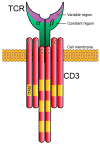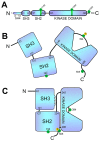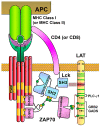A Story of Kinases and Adaptors: The Role of Lck, ZAP-70 and LAT in Switch Panel Governing T-Cell Development and Activation
- PMID: 37759563
- PMCID: PMC10525366
- DOI: 10.3390/biology12091163
A Story of Kinases and Adaptors: The Role of Lck, ZAP-70 and LAT in Switch Panel Governing T-Cell Development and Activation
Abstract
Specific antigen recognition is one of the immune system's features that allows it to mount intense yet controlled responses to an infinity of potential threats. T cells play a relevant role in the host defense and the clearance of pathogens by means of the specific recognition of peptide antigens presented by antigen-presenting cells (APCs), and, to do so, they are equipped with a clonally distributed antigen receptor called the T-cell receptor (TCR). Upon the specific engagement of the TCR, multiple intracellular signals are triggered, which lead to the activation, proliferation and differentiation of T lymphocytes into effector cells. In addition, this signaling cascade also operates during T-cell development, allowing for the generation of cells that can be helpful in the defense against threats, as well as preventing the generation of autoreactive cells. Early TCR signals include phosphorylation events in which the tyrosine kinases Lck and ZAP70 are involved. The sequential activation of these kinases leads to the phosphorylation of the transmembrane adaptor LAT, which constitutes a signaling hub for the generation of a signalosome, finally resulting in T-cell activation. These early signals play a relevant role in triggering the development, activation, proliferation and apoptosis of T cells, and the negative regulation of these signals is key to avoid aberrant processes that could generate inappropriate cellular responses and disease. In this review, we will examine and discuss the roles of the tyrosine kinases Lck and ZAP70 and the membrane adaptor LAT in these cellular processes.
Keywords: CD3; ITAMs; LAT; Lck; TCR; ZAP70; signaling.
Conflict of interest statement
The authors declare no conflict of interest. The funders had no role in the design of the study; in the collection, analyses or interpretation of the data; in the writing of the manuscript; or in the decision to publish the results.
Figures









Similar articles
-
A Novel, LAT/Lck Double Deficient T Cell Subline J.CaM1.7 for Combined Analysis of Early TCR Signaling.Cells. 2021 Feb 6;10(2):343. doi: 10.3390/cells10020343. Cells. 2021. PMID: 33562083 Free PMC article.
-
Lck promotes Zap70-dependent LAT phosphorylation by bridging Zap70 to LAT.Nat Immunol. 2018 Jul;19(7):733-741. doi: 10.1038/s41590-018-0131-1. Epub 2018 Jun 18. Nat Immunol. 2018. PMID: 29915297 Free PMC article.
-
T cell receptor signal initiation induced by low-grade stimulation requires the cooperation of LAT in human T cells.PLoS One. 2010 Nov 30;5(11):e15114. doi: 10.1371/journal.pone.0015114. PLoS One. 2010. PMID: 21152094 Free PMC article.
-
T cell activation at the immunological synapse: vesicles emerge for LATer signaling.Sci Signal. 2010 May 11;3(121):pe16. doi: 10.1126/scisignal.3121pe16. Sci Signal. 2010. PMID: 20460646 Review.
-
How the Discovery of the CD4/CD8-p56lck Complexes Changed Immunology and Immunotherapy.Front Cell Dev Biol. 2021 Mar 15;9:626095. doi: 10.3389/fcell.2021.626095. eCollection 2021. Front Cell Dev Biol. 2021. PMID: 33791292 Free PMC article. Review.
Cited by
-
Metabolic reprogram and T cell differentiation in inflammation: current evidence and future perspectives.Cell Death Discov. 2025 Mar 28;11(1):123. doi: 10.1038/s41420-025-02403-1. Cell Death Discov. 2025. PMID: 40155378 Free PMC article. Review.
-
The quantum model of T-cell activation: Revisiting immune response theories.Scand J Immunol. 2024 Aug;100(2):e13375. doi: 10.1111/sji.13375. Epub 2024 May 15. Scand J Immunol. 2024. PMID: 38750629 Free PMC article.
-
[Transcriptome sequencing for identification of the genes associated with restenosis of venous grafts in rabbits].Nan Fang Yi Ke Da Xue Xue Bao. 2023 Oct 20;43(10):1804-1809. doi: 10.12122/j.issn.1673-4254.2023.10.20. Nan Fang Yi Ke Da Xue Xue Bao. 2023. PMID: 37933658 Free PMC article. Chinese.
-
Editorial: Mechanisms of early intracellular signaling in T lymphocytes.Front Immunol. 2025 Jun 17;16:1638330. doi: 10.3389/fimmu.2025.1638330. eCollection 2025. Front Immunol. 2025. PMID: 40599772 Free PMC article. No abstract available.
-
Exploring the Underlying Mechanism of Weiling Decoction Alleviates Cold-Dampness Diarrhea Based on Network Pharmacology, Transcriptomics, Molecular Docking and Experimental Validation.Pharmaceuticals (Basel). 2025 Jan 16;18(1):109. doi: 10.3390/ph18010109. Pharmaceuticals (Basel). 2025. PMID: 39861171 Free PMC article.
References
Publication types
Grants and funding
- PY20_01297/Consejería de Transformación Económica, Industria, Conocimiento y Universidades, Junta de Andalucía, Spain
- PID2020-113943RB-I00/Agencia Estatal de Investigación, Ministerio de Ciencia e Innovación, Spain
- PR2022-037/University of Cádiz
- PAIDI2020/DOC_01433/Consejería de Transformación Económica, Industria, Conocimiento y Universidades, Junta de Andalucía, Spain
LinkOut - more resources
Full Text Sources
Research Materials
Miscellaneous

